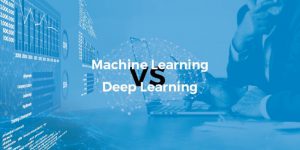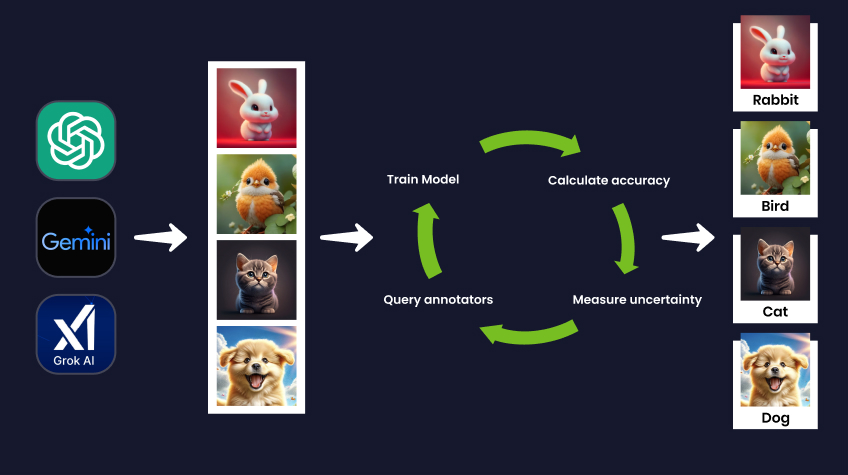
Data annotation has become a revolutionary and incredible element in various industries and organizations that use Machine Learning (ML). With its ability to annotate datasets, it has become an essential tool for training AI and machine learning algorithms with high-quality datasets. If you want to learn more about Data annotation, then this article is for you. This article will take a look into the information about data annotation tech. Here, we will walk you through the details of data annotation and its types. So, keep reading this article to gain an in-depth understanding of data annotation. So, let’s get started…
Table of Contents
What Is a Data Annotation Tech?
Data annotation is a crucial process in Machine Learning. This process includes labeling data to show the results you want your machine learning model to predict. This makes machine algorithms learn high-quality organized datasets. In this process, data scientists add meaningful tags to a dataset. They mark – label, tag, transcribe, or process a dataset with the features that they want the machine learning system to learn to recognize. Based on the annotated high-quality datasets, AI applications like chatbots, virtual assistants, speech recognition, and so much more function efficiently.
In recent years, the need for data annotation and data engineer has grown immensely. There was a time when unorganized data available, such as social media posts, images, emails, and others, got recognition. But, with the introduction of machine learning, data annotation has become very popular. Ever since the machine algorithms started advancing, they found that unorganized data could not help them. Instead, organized data that data scientists could provide in the form of annotation could work wonders. Data annotation tech has become the reason for machine algorithms’ exceptional performance.
In today’s competitive market, businesses and organizations should necessarily work on data annotation. Training the AI model with unstructured datasets is impossible. Businesses need to put meaningful and informative tags on datasets to make AI models learn their business cycle. The more machine learnings are informed, the better they respond to business organizations’ needs.
Let’s now see how AI and ML work. Here we go…
How Does It Work in AI and Machine Learning
Do you know how the AI models work according to the customized needs of customers? Data annotation trains AI models to work according to business objectives, team directions, and customer satisfaction. Otherwise, the purpose of the AI tool can be lost somewhere.
As we all know that machine learning algorithms think like human brains. Human brains come naturally trained to determine the pattern and sequence in datasets. In the similar vein, machine algorithms are trained to recognize and make differences between data patterns and sequences.
During that period, annotated datasets play a major role. Tagging or labeling data enhances their comprehension, akin to the way the human brain processes information. By understanding the business goals, business functioning, team expectations, and customer preferences, they can gain a comprehensive understanding of the situation. For optimal results with data sets, it is advisable to seek assistance from a knowledgeable scientist.
Types of Data Annotation
Here are 6 different types of data annotations. Take a look…
1. Large Language Models (LLM) Annotation
The first type of data annotation is the Large Language Model annotation. This efficiently works to enhance the capabilities of Natural Language Processing (NLP). For this purpose, it works with encoder-decoder and transformer models. It aims to train machine algorithms to recognize, detect, train, and, analyze datasets. In such a manner, it effectively works to generate text or create other content forms.
Let’s understand through the following models how LLM annotation works:
➯ Encoder-Decoder Models
The encoder is accountable for extracting the relevant information from the provided dataset. On the other hand, the decoder deftly generates text based on the relevant information. These two models are integral parts of the LLM models to work wonders.
First of all, you need to encode annotated data into the system of the AI model. This ensures that the AI model knows the language or basic information of your organization. When you input any command, it can use the encoded information to generate text in the target language.
➯ Transformer-Based Models
Earlier, the encoder and decoder models were dependent on RNN models. But, now, they are not based on the RNN models but on transformer-made models that have self-attention capabilities. The researchers of Google developed this model. Since then, they have revolutionized the entire system. Now, this is not difficult for machine algorithms to encode the meaning of datasets.
The major advantage of using transformer-based models is that the encoder and decoder can extract meanings from a sequence of text these days. They have made it possible to understand the meaning or relationship between words and phrases.
➯ LLM Data Annotation Uses
Take a closer look at the following pointers to know the practical application of the LLM:
- Document Annotation: This includes tagging or labeling documents to categorize them into different categories or groups.
- Sentiment Labelling: This tags the sentiment of the text’s tone. For example, It labels the text’s tone as cognitive, positive, or neutral.
- Text Recognition: It involves recognition of the text. For instance, it tags locations, organizations, and people so that machine algorithms can recognize their differences. Likewise, it labels the genre of the text as well for algorithms’ better understanding.
- Intent Detection: This is highly useful to improve customers’ satisfaction. Machine algorithms are trained to identify the intent of customers’ text. This learning ensures AI chatbots have seamless conversations with consumers in real time.
2. Image Annotation
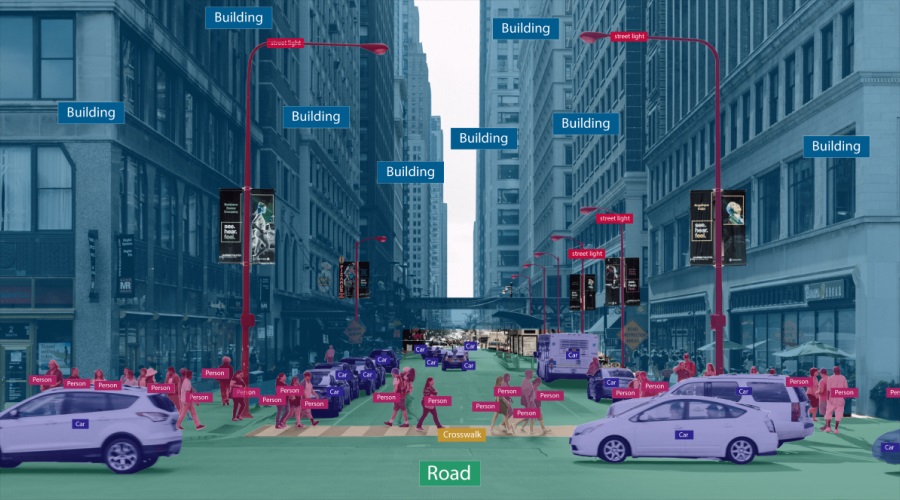
Image annotation is another type of data annotation. This involves labeling or tagging digital images. These tags become high-quality data sources for machine algorithms to understand, recognize, and analyze different types of images. For this purpose, you can take the help of a machine learning engineer for image annotation purposes.
Take a look at the following types of image annotation to understand how this works:
➯ Image Classification
Image classification aims to identify objects within an image. This does not include the procedure of localizing them within an image. To ensure its efficiency, an image data scientist classifies and tags different images into different categories. Machine algorithms understand and store this basic knowledge in their memory to generate fake real images.
➯ Object Identification and Recognition
This type of image annotation includes the localizing of images. For this purpose, the annotations come in the form of bounding boxes. Bounding boxes are rectangular that surround the person or object within an image. They aim to find the location of individual objects within the image.
➯ Image Segmentation
Another type of image annotation is image segmentation. This divides a digital image into segments of pixels. In such a manner, it trains machine algorithms on how to detect object boundaries and backgrounds. They leverage the benefits of pixel-based image segmentation to classify the objects and backgrounds an image contains.
➯ Pose Estimation
Pose annotation aims to ensure that AI machine algorithms recognize the position and orientation of a person or an object. It emphasizes the key points on the body such as knees, elbows, shoulders, hips, wrists, or other body parts. The major advantage of using these pose estimations is to recognize the movements of patients with neurological disorders. As a result of this identification, doctors get a big help in advancing medical treatment.
Also Read:
3. Video Annotation
The next data annotation type includes Video annotation. Video annotation, as the name says, is used to tag or label video clips that are used to train machine algorithms to their best levels. By learning these annotated objects, AI models become efficient in detecting or identifying objects within the video. They annotate objects on a frame-on-frame basis. In this way, they ensure that algorithms do not encounter any kind of complications in understanding and identifying objects.
Go over the following details to understand the types of video annotations:
➯ Bounding Boxes
The most popular type of video annotation is bounding boxes. First of all, a rectangular box is drawn around an object or person. Then, annotations are added to the bounding boxes to enhance the identification capabilities of computer algorithms. This method ensures that whenever algorithms find such types of images, they can automatically identify similar types of images.
➯ Polygon Annotation
This type of annotation identifies complex objects. Usually, this is used to train algorithms regarding objects regardless of their shapes. Furthermore, you can use this annotation to identify objects with abstract shapes.
➯ Semantic Segmentation
Semantic segmentation is another type of video annotation that divides an object into its parts. This can effectively work with multiple videos and ensure videos’ quick processing time as well as high-performing output. In this method, the engineer annotates the components of an object. As a result of this, computer algorithms recognize and remember these parts effectively.
➯ Key Point Segmentation
Key point segmentation outlines the key points of the body. This highlights the face, arms, legs, elbows, and shoulders of a person in the video. This ensures that algorithms can identify movements based on these key points.
➯ 3D Cuboid Annotation
This type of annotation draws a cube over an object to get 3D perspectives. This type of annotation trains algorithms on the identification and differentiation of road scenes such as buses, vans, cars, pedestrians, and pavement.
4. Text Annotation
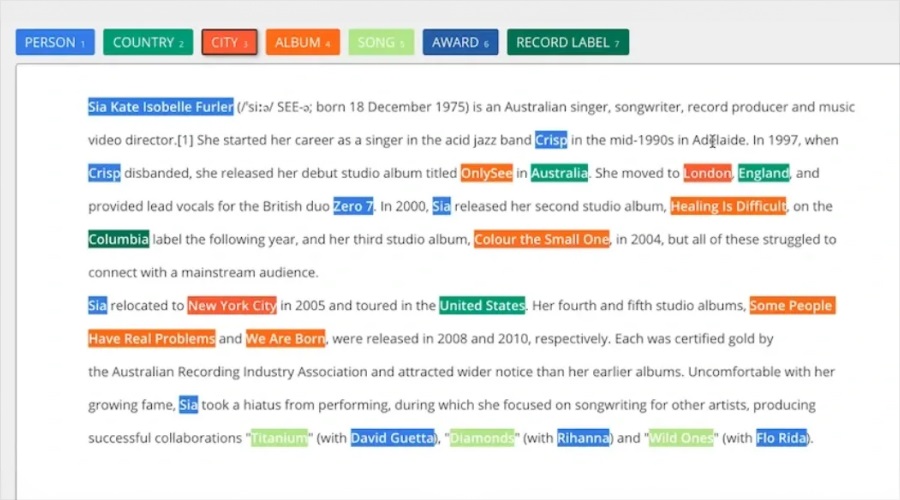
Text annotation is yet another type of data annotation. It involves the process of adding metadata or labels to textual data. Text annotation makes the data more understandable and usable for machine learning models and artificial intelligence systems. Adding metadata provides context and structure to the text, allowing machine algorithms to process and analyze it efficiently. Annotated text improves machine algorithms. They provide labeled examples that machine learning models can use to learn patterns and make predictions. In addition, it helps develop NLP applications like chatbots, virtual assistants, and so on. They also help in indexing and retrieving information from large text corpora. Here are the different types of Text Annotation
➯ Named Entity Recognition (NER)
NER or Named Entity Recognition helps identify and label entities within the text, such as names of people, organizations, locations, dates, and other proper nouns. For example, “Cleeta works in London in Deloitte.” In this sentence, “Cleeta,” “London,” and “Deloitte” would be labeled as entities.
➯ Part of Speech Tagging (POS)
In this, the words in a sentence will be labeled with its corresponding part of speech, such as noun, verb, adverb adjective, etc.
➯ Sentiment Annotation
Sentiment annotation, as the name says, determines the sentiment or emotion expressed in the text. These emotions range from positive to negative, and neutral. For example, “I hate summer season.” This sentence would be labeled as negative sentiment.
➯ Intent Annotation
As the name suggests, it identifies the underlying intention behind the text. Intent annotation is used natural language processing for chatbots and virtual assistants to help companies offer excellent user experience to their customers. For example, “Why my internet is not working?” would be labeled as an inquiry related to an internet issue.
➯ Text Classification
The process of text classification includes categorizing complete documents or text segments into predefined categories or topics. For instance, sorting news articles into different categories like entertainment, sports, politics, and so on.
5. Audio Annotation
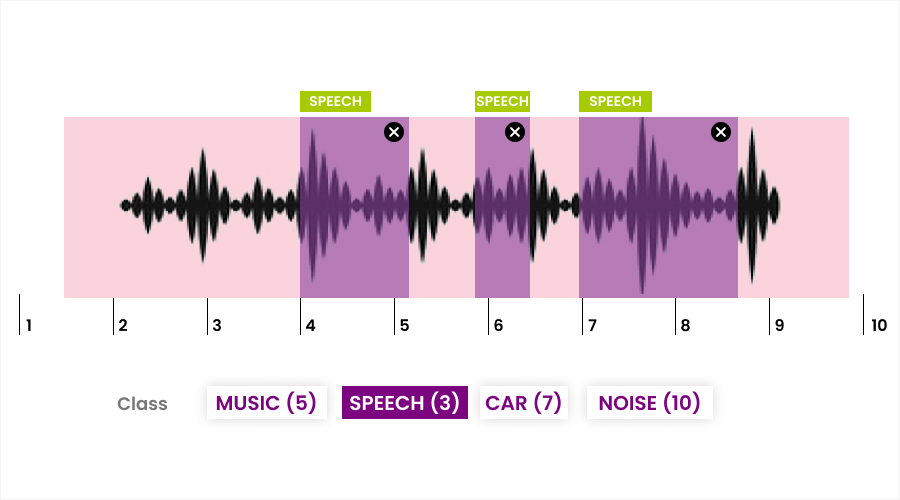
Another type of data annotation includes Audio annotation. Audio annotation helps AI algorithms understand audio recordings. This procedure involves the incorporation of annotations or comments into the data recording. With the help of the audio annotation, various activities such as research analysis and education instructions become seamless.
Let’s understand the following types of audio annotation in a simplified manner:
➯ Speech into Text Annotation
This annotation label ensures advancements in natural language processing. In this method, not only the audio but also the sound is transcribed. This procedure makes AI models become efficient in transforming speech into text.
➯ Music Annotation
Another audio annotation includes music annotation. This type of audio annotation labels music genres and instruments into various categories. This method guarantees that machine algorithms will improve their ability to organize music libraries.
➯ Speech Labelling
This annotation helps in developing AI chatbots that can perform repetitive speech tasks. In this method, data scientists separate the requested sounds from an audio recording. Then, they efficiently tag these sounds with keywords.
➯ Audio Classification
Virtual assistants highly rely on the efficiency of the audio classification technique. This is because it allows machine algorithms to recognize and distinguish individual voices and their sounds effortlessly.
➯ Natural Language Utterance
This annotation tags or labels minute details of a human speech. Often, these details include intonation, dialects, contexts, and semantics. They are considered effective in developing AI virtual assistants.
6. LiDAR Annotation

LiDAR stands for Light, Detection, and Ranging. This type of annotation ensures that machine algorithms get accurate and speedy information about the positioning and sizes of the objects. Therefore, it labels objects within a 3D print cloud with the help of laser beams.
Conclusion
So, this is all about data annotation technology. Hopefully, with this post, you will have understood how important data annotation technology is in today’s era. It plays a pivotal role in the advancement of artificial intelligence and machine learning applications. Through careful data labelling, machine algorithms are able to learn and make precise predictions, leading to advancements in industries like finance, healthcare, autonomous driving, and more.
The precision and quality of annotated data directly influence the effectiveness and reliability of AI systems, featuring the importance of robust annotation processes and tools. Given the increasing demand for AI solutions, it is imperative to focus on the development and improvement of data annotation techniques. These techniques help in the creation of more advanced and intelligent systems that can revolutionize our lives and work. Investing in cutting-edge data annotation technology and highly skilled annotators will play a crucial role in unleashing the complete potential of AI, resulting in revolutionary advancements and a more intelligent and streamlined future.
FAQs
Q1. Is data annotation difficult?
It is very complicated to label or tag datasets to train machine algorithms. For this, a highly qualified data engineer or automated tool is required. The chosen person or tool should be skilled and experienced. They must have the ability to pay attention to the minute details of different types of datasets.
Q2. Is there any future in data annotation?
Data annotation is surely going to rise. As the demand for AI and ML is increasing, the demand for data annotation is sure to increase in future. High-quality annotated data can make AI algorithms understand real-world data. In the upcoming years, the demand for highly qualified annotators can increase to a great extent.
Q3. Who needs data annotation?
Any organization or industry that needs to integrate an AI model into its systems needs data annotation.
Happy Data Annotating… 😊 😊






